3-(1,2,3-Triazol-4-yl)-β-Carbolines and 3-(1H-Tetrazol-5-yl)-β-Carbolines: Synthesis and Evaluation as Anticancer Agents
Abstract
1. Introduction
2. Results and Discussion
2.1. Chemistry
2.2. Anticancer Activity
3. Experimental Section
3.1. Chemistry
3.1.1. General Information
3.1.2. 1-(1-(p-Chlorophenyl)-1H-1,2,3-triazol-4-yl)-2-(1H-indol-3-yl)ethanamine (11)
3.1.3. General Procedure for the Synthesis of Tetrahydro-β-carbolines 12
3-(1-(p-Chlorophenyl)-1H-1,2,3-triazol-4-yl)-1-phenyl-tetrahydro-β-carboline (12a)
3-(1-(p-Chlorophenyl)-1H-1,2,3-triazol-4-yl)-1-(p-fluorophenyl)-tetrahydro-β-carboline (12b)
3-(1-(p-Chlorophenyl)-1H-1,2,3-triazol-4-yl)-1-(p-methoxyphenyl)-tetrahydro-β-carboline (12c)
3-(1-(p-Chlorophenyl)-1H-1,2,3-triazol-4-yl)-1-(p-dimethylaminophenyl)-tetrahydro-β-carboline (12d)
3-(1-(p-Chlorophenyl)-1H-1,2,3-triazol-4-yl)-1-(m-nitrophenyl)-tetrahydro-β-carboline (12e)
3-(1-(p-Chlorophenyl)-1H-1,2,3-triazol-4-yl)-1-(o-chlorophenyl)-tetrahydro-β-carboline (12f)
3.1.4. General Procedure for the Synthesis of β-Carbolines 13
3-(1-(p-Chlorophenyl)-1H-1,2,3-triazol-4-yl)-1-phenyl-β-carboline (13a)
3-(1-(p-Chlorophenyl)-1H-1,2,3-triazol-4-yl)-1-(p-fluorophenyl)-β-carboline (13b)
3-(1-(p-Chlorophenyl)-1H-1,2,3-triazol-4-yl)-1-(p-methoxyphenyl)-β-carboline (13c)
3-(1-(p-Chlorophenyl)-1H-1,2,3-triazol-4-yl)-1-(p-dimethylaminophenyl)-β-carboline (13d)
3-(1-(p-Chlorophenyl)-1H-1,2,3-triazol-4-yl)-1-(m-nitrophenyl)-β-carboline (13e)
3-(1-(p-Chlorophenyl)-1H-1,2,3-triazol-4-yl)-1-(o-chlorophenyl)-β-carboline (13f)
3.2. Anticancer Activity
3.2.1. Human Cell Lines
3.2.2. Sulforhodamine B (SRB) Assay
3.2.3. Annexin-V Assay
4. Conclusions
Supplementary Materials
Author Contributions
Funding
Institutional Review Board Statement
Informed Consent Statement
Data Availability Statement
Acknowledgments
Conflicts of Interest
References
- Sung, H.; Ferlay, J.; Siegel, R.L.; Laversanne, M.; Soerjomataram, I.; Jemal, A.; Bray, F. Global Cancer Statistics 2020: GLOBOCAN Estimates of Incidence and Mortality Worldwide for 36 Cancers in 185 Countries. CA Cancer J. Clin. 2021, 71, 209–249. [Google Scholar] [CrossRef] [PubMed]
- Ashok, P.; Chander, S.; Balzarini, J.; Pannecouque, C.; Murugesan, S. Design, synthesis of new β-carboline derivatives and their selective anti-HIV-2 activity. Bioorg. Med. Chem. Lett. 2015, 25, 1232–1235. [Google Scholar] [CrossRef] [PubMed]
- Faheem; Kumar, K.B.; Sekhar, G.C.K.V.; Kunjiappan, S.; Jamalis, J.; Balaña-Fouce, R.; Sankaranarayanan, M. Recent Update on the Anti-infective Potential of β-carboline Analogs. Mini-Rev. Med. Chem. 2021, 21, 398–425. [Google Scholar] [CrossRef]
- Wang, J.; Gong, F.; Liang, T.; Xie, Z.; Yang, Y.; Cao, C.; Gao, J.; Lu, T.; Chen, X. A review of synthetic bioactive tetrahydro-β-carbolines: A medicinal chemistry perspective. Eur. J. Med. Chem. 2021, 225, 113815. [Google Scholar] [CrossRef] [PubMed]
- Venkataramana Reddy, P.O.; Hridhay, M.; Nikhil, K.; Khan, S.; Jha, P.N.; Shah, K.; Kumar, D. Synthesis and investigations into the anticancer and antibacterial activity studies of β-carboline chalcones and their bromide salts. Bioorg. Med. Chem. Lett. 2018, 28, 1278–1282. [Google Scholar] [CrossRef] [PubMed]
- Gorki, V.; Walter, N.S.; Singh, R.; Chauhan, M.; Dhingra, N.; Salunke, D.B.; Kaur, S. β-Carboline Derivatives Tackling Malaria: Biological Evaluation and Docking Analysis. ACS Omega 2020, 5, 17993–18006. [Google Scholar] [CrossRef]
- Szabó, T.; Volk, B.; Milen, M. Recent Advances in the Synthesis of β-Carboline Alkaloids. Molecules 2021, 26, 663. [Google Scholar] [CrossRef]
- Panice, M.R.; Lopes, S.M.M.; Figueiredo, M.C.; Goes Ruiz, A.L.T.; Foglio, M.A.; Nazari Formagio, A.S.; Sarragiotto, M.H.; Pinho e Melo, T.M.V.D. New 3-tetrazolyl-β-carbolines and β-carboline-3-carboxylates with anti-cancer activity. Eur. J. Med. Chem. 2019, 179, 123–132. [Google Scholar] [CrossRef]
- Han, Y.; Dong, W.; Guo, Q.; Li, X.; Huang, L. The importance of indole and azaindole scaffold in the development of antitumor agents. Eur. J. Med. Chem. 2020, 203, 112506. [Google Scholar] [CrossRef]
- Culjat, M.; Huizenga, M.N.; Forcelli, P.A. Age-dependent anticonvulsant actions of perampanel and brivaracetam in the methyl-6,7-dimethoxy-4-ethyl-beta-carboline-3-carboxylate (DMCM) model of seizures in developing rats. Pharmacol. Rep. 2021, 73, 296–302. [Google Scholar] [CrossRef]
- Farzin, D.; Mansouri, N. Antidepressant-like effect of harmane and other β-carbolines in the mouse forced swim test. Eur. Neuropsychopharmacol. 2006, 16, 324–328. [Google Scholar] [CrossRef] [PubMed]
- Tewari, U.; Sharma, D.; Srivastava, S.; Kumar, B.K.; Faheem; Murugesan, S. Anti-Tubercular Insights of Carbolines—A Decade Critique. ChemistrySelect 2021, 6, 2428–2445. [Google Scholar] [CrossRef]
- Pavić, K.; Beus, M.; Poje, G.; Uzelac, L.; Kralj, M.; Rajić, Z. Synthesis and Biological Evaluation of Harmirins, Novel Harmine–Coumarin Hybrids as Potential Anticancer Agents. Molecules 2021, 26, 6490. [Google Scholar] [CrossRef] [PubMed]
- Ayipo, Y.O.; Osunniran, W.A.; Mordi, M.N. Metal complexes of β-carboline: Advances in anticancer therapeutics. Coord. Chem. Rev. 2021, 432, 213746. [Google Scholar] [CrossRef]
- Luo, B.; Song, X. A comprehensive overview of β-carbolines and its derivatives as anticancer agents. Eur. J. Med. Chem. 2021, 224, 113688. [Google Scholar] [CrossRef]
- Pontes, O.; Oliveira-Pinto, S.; Baltazar, F.; Costa, M. Renal cell carcinoma therapy: Current and new drug candidates. Drug Discov. Today 2022, 27, 304–314. [Google Scholar] [CrossRef]
- Soni, J.P.; Yeole, Y.; Shankaraiah, N. β-Carboline-based molecular hybrids as anticancer agents: A brief sketch. RSC Med. Chem. 2021, 12, 730–750. [Google Scholar] [CrossRef]
- Aaghaz, S.; Sharma, K.; Jain, R.; Kamal, A. β-Carbolines as potential anticancer agents. Eur. J. Med. Chem. 2021, 216, 113321. [Google Scholar] [CrossRef]
- Kumar, S.; Singh, A.; Kumar, K.; Kumar, V. Recent insights into synthetic β-carbolines with anti-cancer activities. Eur. J. Med. Chem. 2017, 142, 48–73. [Google Scholar] [CrossRef]
- Maity, P.; Adhikari, D.; Jana, A.K. An overview on synthetic entries to tetrahydro-β-carbolines. Tetrahedron 2019, 75, 965–1028. [Google Scholar] [CrossRef]
- Lopes, S.M.M.; Novais, J.S.; Costa, D.C.S.; Castro, H.C.; Figueiredo, A.M.S.; Ferreira, V.F.; Pinho e Melo, T.M.V.D.; da Silva, F.d.C. Hetero-Diels-Alder reactions of novel 3-triazolyl-nitrosoalkenes as an approach to functionalized 1,2,3-triazoles with antibacterial profile. Eur. J. Med. Chem. 2018, 143, 1010–1020. [Google Scholar] [CrossRef] [PubMed]
- Lopes, S.M.M.; Lemos, A.; Melo, T.M.V.D.P.e. A hetero-Diels–Alder approach to functionalized 1H-tetrazoles: Synthesis of tetrazolyl-1,2-oxazines, -oximes and 5-(1-aminoalkyl)-1H-tetrazoles. Tetrahedron Lett. 2010, 51, 6756–6759. [Google Scholar] [CrossRef]
- Lopes, S.M.M.; Palacios, F.; Lemos, A.; Pinho e Melo, T.M.V.D. Diels–Alder reactions of 3-(1H-tetrazol-5-yl)-nitrosoalkenes: Synthesis of functionalized 5-(substituted)-1H-tetrazoles. Tetrahedron 2011, 67, 8902–8909. [Google Scholar] [CrossRef]
- Lopes, S.M.M.; Nunes, S.C.C.; Carato, C.C.; Pais, A.A.C.C.; Pinho e Melo, T.M.V.D. Reactivity of 1-arylnitrosoethylenes towards indole derivatives. Monatsh. Chem. 2016, 147, 1565–1573. [Google Scholar] [CrossRef]
- Lopes, S.M.M.; Cardoso, A.L.; Lemos, A.; Pinho e Melo, T.M.V.D. Recent Advances in the Chemistry of Conjugated Nitrosoalkenes and Azoalkenes. Chem. Rev. 2018, 118, 11324–11352. [Google Scholar] [CrossRef]
- Kumar, S.; Sharma, B.; Mehra, V.; Kumar, V. Recent accomplishments on the synthetic/biological facets of pharmacologically active 1H-1,2,3-triazoles. Eur. J. Med. Chem. 2021, 212, 113069. [Google Scholar] [CrossRef]
- Kumar, S.; Khokra, S.L.; Yadav, A. Triazole analogues as potential pharmacological agents: A brief review. Future J. Pharm. Sci. 2021, 7, 106. [Google Scholar] [CrossRef]
- Dixit, D.; Verma, P.K.; Marwaha, R.K. A review on ‘triazoles’: Their chemistry, synthesis and pharmacological potentials. J. Iran Chem. Soc. 2021, 18, 2535–2565. [Google Scholar] [CrossRef]
- Forezi, L.S.M.; Lima, C.G.S.; Amaral, A.A.P.; Ferreira, P.G.; Souza, M.C.B.V.; Cunha, A.C.; Silva, F.C.d.; Ferreira, V.F. Bioactive 1,2,3-Triazoles: An Account on their Synthesis, Structural Diversity and Biological Applications. Chem. Rec. 2021, 21, 1–27. [Google Scholar] [CrossRef]
- Matin, M.M.; Matin, P.; Rahman, M.R.; Ben Hadda, T.; Almalki, F.A.; Mahmud, S.; Ghoneim, M.M.; Alruwaily, M.; Alshehri, S. Triazoles and Their Derivatives: Chemistry, Synthesis, and Therapeutic Applications. Front. Mol. Biosci. 2022, 9, 864286. [Google Scholar] [CrossRef]
- Saroha, B.; Kumar, G.; Kumar, R.; Kumari, M.; Kumar, S. A minireview of 1,2,3-triazole hybrids with O-heterocycles as leads in medicinal chemistry. Chem. Biol. Drug Des. 2022, 100, 843–869. [Google Scholar] [CrossRef] [PubMed]
- Selig, D.J.; DeLuca, J.P.; Chung, K.K.; Pruskowski, K.A.; Livezey, J.R.; Nadeau, R.J.; Por, E.D.; Akers, K.S. Pharmacokinetics of piperacillin and tazobactam in critically Ill patients treated with continuous kidney replacement therapy: A mini-review and population pharmacokinetic analysis. J. Clin. Pharm. Ther. 2022, 47, 1091–1102. [Google Scholar] [CrossRef]
- Coenen, S.; Ferech, M.; Dvorakova, K.; Hendrickx, E.; Suetens, C.; Goossens, H.; ESAC Project Group. European Surveillance of Antimicrobial Consumption (ESAC): Outpatient cephalosporin use in Europe. J. Antimicrob. Chemother. 2006, 58, 413–417. [Google Scholar] [CrossRef] [PubMed]
- Si, X.; Wang, J.; Cheng, Y.; Shi, J.; Cui, L.; Zhang, H.; Huang, Y.; Liu, W.; Chen, L.; Zhu, J.; et al. A phase III, randomized, double-blind, controlled trial of carboxyamidotriazole plus chemotherapy for the treatment of advanced non-small cell lung cancer. Ther. Adv. Med. Oncol. 2020, 12, 1–9. [Google Scholar] [CrossRef] [PubMed]
- Haroun, M.; Tratrat, C.; Kochkar, H.; Nair, B.A. Recent Advances in the Development of 1,2,3-Triazole-containing Derivatives as Potential Antifungal Agents and Inhibitors of Lanoster ol 14α-Demethylase. Curr. Top. Med. Chem. 2021, 21, 462–506. [Google Scholar] [CrossRef] [PubMed]
- Zhang, B. Comprehensive review on the anti-bacterial activity of 1,2,3-triazole hybrids. Eur. J. Med. Chem. 2019, 168, 357–372. [Google Scholar] [CrossRef]
- Upadhyay, C.H. Coumarin-1,2,3-triazole Hybrid Molecules: An Emerging Scaffold for Combating Drug Resistance. Curr. Top. Med. Chem. 2021, 21, 737–752. [Google Scholar] [CrossRef]
- Li, J.; Zhang, J. The Antibacterial Activity of 1,2,3-triazole- and 1,2,4-Triazole-containing Hybrids against Staphylococcus aureus: An Updated Review (2020- Present). Curr. Top. Med. Chem. 2022, 22, 41–63. [Google Scholar] [CrossRef]
- Feng, L.-S.; Zheng, M.-J.; Zhao, F.; Liu, D. 1,2,3-Triazole hybrids with anti-HIV-1 activity. Arch. Pharm. 2021, 354, e2000163. [Google Scholar] [CrossRef]
- Chu, X.-M.; Wang, C.; Wang, W.-L.; Liang, L.-L.; Liu, W.; Gong, K.-K.; Sun, K.-L. Triazole derivatives and their antiplasmodial and antimalarial activities. Eur. J. Med. Chem. 2019, 166, 206–223. [Google Scholar] [CrossRef]
- Sachdeva, H.; Saquib, M.; Tanwar, K. Design and Development of Triazole Derivatives as Prospective Anticancer Agents: A Review. Anti-Cancer Agents Med. Chem. 2022, 22, 3269–3279. [Google Scholar] [CrossRef]
- Kala, N.; Rahate, P.K. Triazole as Potent Anti-cancer Agent—A Pharmacophoric Scaffold. Curr. Cancer Ther. Rev. 2022, 18, 95–117. [Google Scholar] [CrossRef]
- Bhagat, S.D.; Bumbrah, S.G.; Chawla, A.P.; Gurnule, B.W.; Shejul, K.S. Recent Advances in Synthesis and Anticancer Potential of Triazole-Containing Scaffolds. Anti-Cancer Agents Med. Chem. 2022, 22, 2852–2875. [Google Scholar] [CrossRef]
- Qin, B.; Bai, Q.; Yan, D.; Yin, F.; Zhu, Z.; Xia, C.; Yang, Y.; Zhao, Y. Discovery of novel mRNA demethylase FTO inhibitors against esophageal cancer. J. Enzym. Inhib. Med. Chem. 2022, 37, 1995–2003. [Google Scholar] [CrossRef] [PubMed]
- Rani, A.; Singh, G.; Singh, A.; Maqbool, U.; Kaur, G.; Singh, J. CuAAC-ensembled 1,2,3-triazole-linked isosteres as pharmacophores in drug discovery: Review. RSC Adv. 2020, 10, 5610–5635. [Google Scholar] [CrossRef] [PubMed]
- Pedersen, D.S.; Abell, A. 1,2,3-Triazoles in Peptidomimetic Chemistry. Eur. J. Org. Chem. 2011, 2399–2411. [Google Scholar] [CrossRef]
- Salehi, P.; Babanezhad-Harikandei, K.; Bararjanian, M.; Al-Harrasi, A.; Esmaeili, M.-A.; Aliahmadi, A. Synthesis of novel 1,2,3-triazole tethered 1,3-disubstituted β-carboline derivatives and their cytotoxic and antibacterial activities. Med. Chem. Res. 2016, 25, 1895–1907. [Google Scholar] [CrossRef]
- Shankaraiah, N.; Jadala, C.; Nekkanti, S.; Senwar, K.R.; Nagesh, N.; Shrivastava, S.; Naidu, V.G.M.; Sathish, M.; Kamal, A. Design and synthesis of C3-tethered 1,2,3-triazolo-β-carboline derivatives: Anticancer activity, DNA-binding ability, viscosity and molecular modeling studies. Bioorg. Chem. 2016, 64, 42–50. [Google Scholar] [CrossRef]
- Filali, I.; Belkacem, M.A.; Ben Nejma, A.; Souchard, J.P.; Ben Jannet, H.; Bouajila, J. Synthesis, cytotoxic, anti-lipoxygenase and anti-acetylcholinesterase capacities of novel derivatives from harmine. J. Enzym. Inhib. Med. Chem. 2016, 31, 23–33. [Google Scholar] [CrossRef]
- Formagio, A.S.N.; Tonin, L.T.D.; Foglio, M.A.; Madjarof, C.; de Carvalho, J.E.; da Costa, W.F.; Cardoso, F.P.; Sarragiotto, M.H. Synthesis and antitumoral activity of novel 3-(2-substituted-1,3,4-oxadiazol-5-yl) and 3-(5-substituted-1,2,4-triazol-3-yl) β-carboline derivatives. Biorg. Med. Chem. 2008, 16, 9660–9667. [Google Scholar] [CrossRef]
- Fischer, M. Census and evaluation of p53 target genes. Oncogene 2017, 36, 3943–3956. [Google Scholar] [CrossRef] [PubMed]
- Vousden, K.H.; Prives, C. Blinded by the Light: The Growing Complexity of p53. Cell 2009, 137, 413–431. [Google Scholar] [CrossRef] [PubMed]
- Muller, P.A.J.; Vousden, K.H. Mutant p53 in Cancer: New Functions and Therapeutic Opportunities. Cancer Cell 2014, 25, 304–317. [Google Scholar] [CrossRef]
- Dai, F.; Chen, Y.; Song, Y.; Huang, L.; Zhai, D.; Dong, Y.; Lai, L.; Zhang, T.; Li, D.; Pang, X.; et al. A Natural Small Molecule Harmine Inhibits Angiogenesis and Suppresses Tumour Growth through Activation of p53 in Endothelial Cells. PLoS ONE 2012, 7, e52162. [Google Scholar] [CrossRef] [PubMed]
- Ling, Y.; Xu, C.; Luo, L.; Cao, J.; Feng, J.; Xue, Y.; Zhu, Q.; Ju, C.; Li, F.; Zhang, Y.; et al. Novel β-Carboline/Hydroxamic Acid Hybrids Targeting Both Histone Deacetylase and DNA Display High Anticancer Activity via Regulation of the p53 Signaling Pathway. J. Med. Chem. 2015, 58, 9214–9227. [Google Scholar] [CrossRef] [PubMed]
- Mota, N.S.R.S.; Kviecinski, M.R.; Felipe, K.B.; Grinevicius, V.M.A.S.; Siminski, T.; Almeida, G.M.; Zeferino, R.C.; Pich, C.T.; Filho, D.W.; Pedrosa, R.C. β-carboline alkaloid harmine induces DNA damage and triggers apoptosis by a mitochondrial pathway: Study in silico, in vitro and in vivo. Int. J. Funct. Nutr. 2020, 1, 1. [Google Scholar] [CrossRef]
- Miao, J.; Meng, C.; Wu, H.; Shan, W.; Wang, H.; Ling, C.; Zhang, J.; Yang, T. Novel Hybrid CHC from β-carboline and N-Hydroxyacrylamide Overcomes Drug-Resistant Hepatocellular Carcinoma by Promoting Apoptosis, DNA Damage, and Cell Cycle Arrest. Front. Pharmacol. 2021, 11, 626065. [Google Scholar] [CrossRef] [PubMed]
- Ramos, H.; Soares, M.I.L.; Silva, J.; Raimundo, L.; Calheiros, J.; Gomes, C.; Reis, F.; Monteiro, F.A.; Nunes, C.; Reis, S.; et al. A selective p53 activator and anticancer agent to improve colorectal cancer therapy. Cell Rep. 2021, 35, 108982. [Google Scholar] [CrossRef]
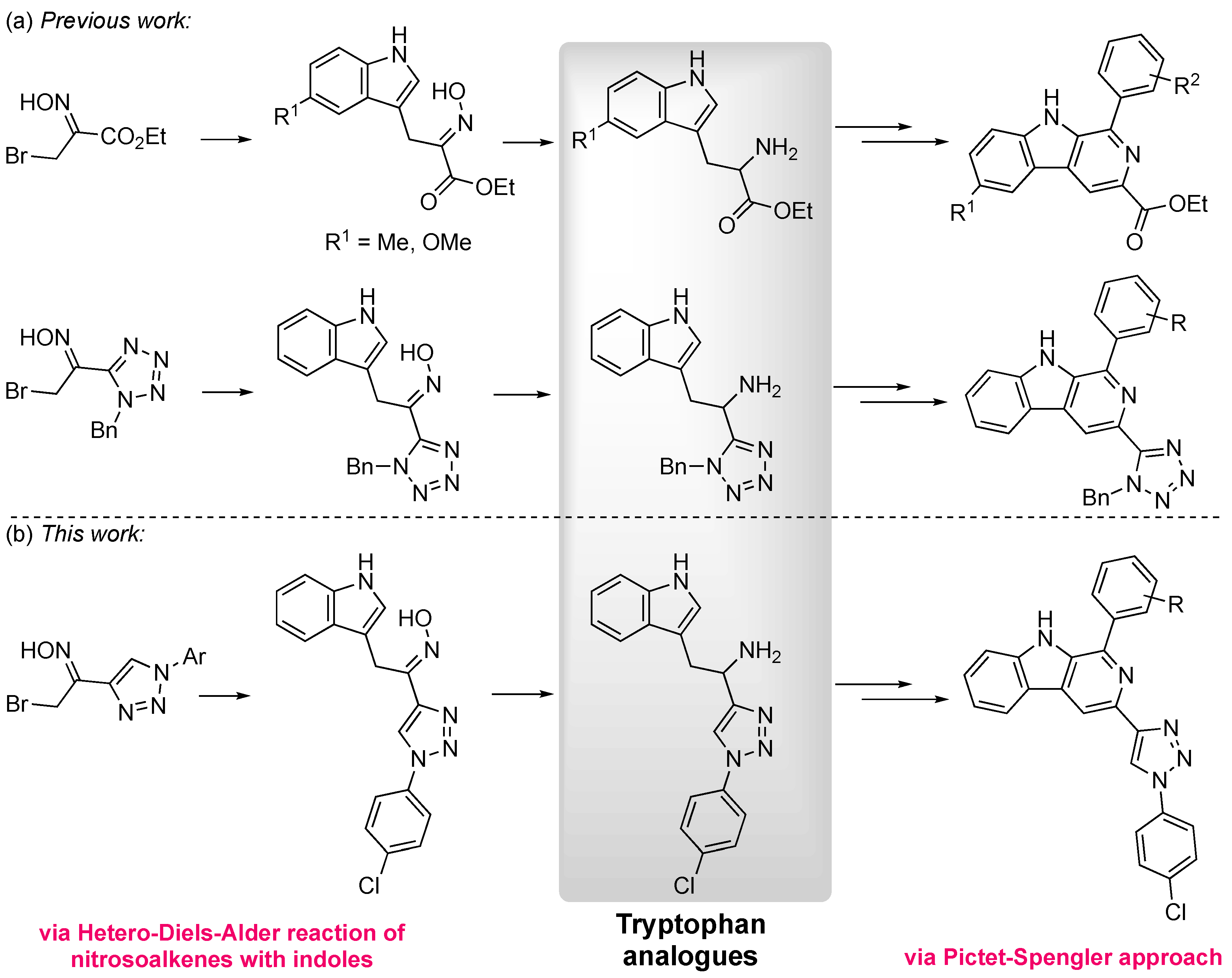


| IC50 (μM) | ||
|---|---|---|
| β-Carboline | HCT116 | HCT116 p53−/− |
| Etoposide | 0.6 ± 0.05 | 0.9 ± 0.07 |
| 13a | 39 ± 2.16 | 43 ± 0.82 |
| 13b | >50 | >50 |
| 13c | 32 ± 2.45 | >50 |
| 13d | >50 | >50 |
| 13e | >50 | >50 |
| 13f | >50 | >50 |
| 1a | 4.5 ± 0.05 | 4.6 ± 0.43 |
| 1b | 4.3 ± 0.08 | 4.2 ± 0.31 |
| 1c | 3.4 ± 0.16 | 3.3 ± 0.73 |
| 14a | >50 | >50 |
| 14b | >50 | >50 |
| 14c | 15 ± 1.41 | 18 ± 0.47 |
| 14d | >50 | >50 |
| 14e | >50 | >50 |
| IC50 (μM) | |||
|---|---|---|---|
| β-Carboline | SW837 | HT29 | CCD-18Co |
| Etoposide | 0.9 ± 0.07 | 0.7 ± 0.1 | 0.5 ± 0.07 |
| 13a | >50 | >50 | >50 |
| 13b | >50 | >50 | >50 |
| 13c | >50 | >50 | >50 |
| 13d | >50 | >50 | >50 |
| 13e | >50 | >50 | >50 |
| 13f | >50 | >50 | >50 |
| 1a | 44 ± 0.82 | 9.0 ± 0.55 | 26 ± 0.82 |
| 1b | 25 ± 1.63 | 5.9 ± 1.19 | 3.4 ± 0.29 |
| 1c | 29 ± 3.74 | 9.6 ± 1.18 | 7.5 ± 0.16 |
| IC50 (μM) | |||||
|---|---|---|---|---|---|
| β-Carboline | HFF-1 | PANC-1 | A375 | HEPG2 | MCF-7 |
| Etoposide | 1.1 ± 0.01 | 3.1 ± 0.05 | 0.9 ± 0.07 | 1.7 ± 0.2 | 2.1 ± 0.03 |
 | 29 ± 1.50 | 4.0 ± 0.40 | 5.6 ± 0.20 | 7.5 ± 1.27 | 7.7 ± 0.70 |
Publisher’s Note: MDPI stays neutral with regard to jurisdictional claims in published maps and institutional affiliations. |
© 2022 by the authors. Licensee MDPI, Basel, Switzerland. This article is an open access article distributed under the terms and conditions of the Creative Commons Attribution (CC BY) license (https://creativecommons.org/licenses/by/4.0/).
Share and Cite
Ribeiro, J.L.P.; Loureiro, J.B.; Lopes, S.M.M.; Saraiva, L.; Pinho e Melo, T.M.V.D. 3-(1,2,3-Triazol-4-yl)-β-Carbolines and 3-(1H-Tetrazol-5-yl)-β-Carbolines: Synthesis and Evaluation as Anticancer Agents. Pharmaceuticals 2022, 15, 1510. https://doi.org/10.3390/ph15121510
Ribeiro JLP, Loureiro JB, Lopes SMM, Saraiva L, Pinho e Melo TMVD. 3-(1,2,3-Triazol-4-yl)-β-Carbolines and 3-(1H-Tetrazol-5-yl)-β-Carbolines: Synthesis and Evaluation as Anticancer Agents. Pharmaceuticals. 2022; 15(12):1510. https://doi.org/10.3390/ph15121510
Chicago/Turabian StyleRibeiro, João L. P., Joana B. Loureiro, Susana M. M. Lopes, Lucília Saraiva, and Teresa M. V. D. Pinho e Melo. 2022. "3-(1,2,3-Triazol-4-yl)-β-Carbolines and 3-(1H-Tetrazol-5-yl)-β-Carbolines: Synthesis and Evaluation as Anticancer Agents" Pharmaceuticals 15, no. 12: 1510. https://doi.org/10.3390/ph15121510
APA StyleRibeiro, J. L. P., Loureiro, J. B., Lopes, S. M. M., Saraiva, L., & Pinho e Melo, T. M. V. D. (2022). 3-(1,2,3-Triazol-4-yl)-β-Carbolines and 3-(1H-Tetrazol-5-yl)-β-Carbolines: Synthesis and Evaluation as Anticancer Agents. Pharmaceuticals, 15(12), 1510. https://doi.org/10.3390/ph15121510









